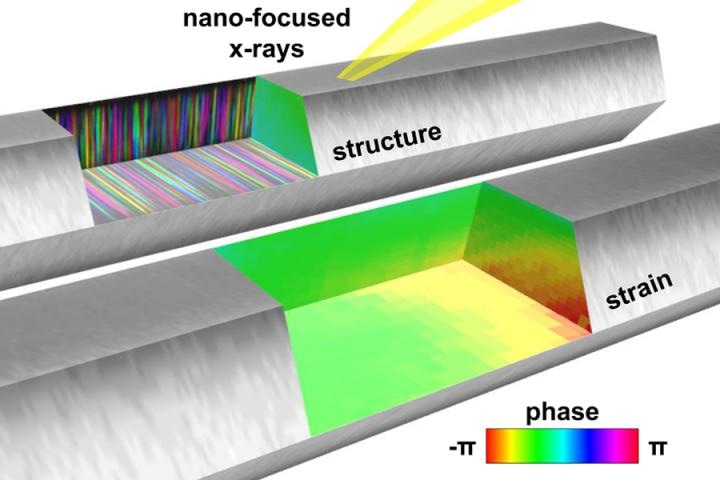Mar 29 2018
Scientists from the U.S. Department of Energy’s (DOE) Argonne and Brookhaven National Laboratories observed, in a new study, the formation of two kinds of defects in single nanowires, which are smaller in diameter than a human hair.
 Argonne and Brookhaven researchers observed two kinds of defects forming in individual nanowires, depicted here. These nanowires are smaller in diameter than a human hair. (Image credit: Megan Hill/Northwestern University)
Argonne and Brookhaven researchers observed two kinds of defects forming in individual nanowires, depicted here. These nanowires are smaller in diameter than a human hair. (Image credit: Megan Hill/Northwestern University)
These nanowires, made of indium gallium arsenide, could be beneficial for a broad range of applications in a field researchers have termed optoelectronics, which includes devices that function by transforming light energy into electrical impulses. Fiber optic relays are a good illustration.
The efficiency of these devices, however, can be influenced by minute defects in their components. These defects, which can modify both the electronic and optical properties of these materials, appeal scientists who seek to customize them to increase the functionality of future optoelectronics, including materials that will be able to regulate quantum information.
In the research, the team, which also involved colleagues from Northwestern University and two European universities, observed two kinds of defects in a single nanowire. The first kind of defect, resulting from the strain, affects the whole nanowire, stopping it from growing flawlessly straight. The second kind of defect, known as a stacking fault, happens close to the atomic level, as individual planes of atoms are laid down to extend the nanowire.
To visualize the difference between stacking faults and strain, you can think of shuffling a deck of cards. A stacking fault occurs when a card from the deck is shuffled imperfectly - as if two cards come from the right hand before one can come from the left.
Stephan Hruszkewycz, Study Author & Argonne Materials Scientist
Strain, Hruszkewycz explained, “looks as if a tower of decks of cards were tilted in a certain direction instead of standing perfectly straight.”
Since stacking faults and strain happen at such diverse scales, understanding how they interact to modify a nanowire’s features requires researchers to use advanced imaging technology and tough mathematical algorithms.
By using a method called Bragg ptychography to view the defects, the Argonne researchers created a technique they could use to observe the nanowire within its operating environment.
We’ve developed a technique that allows us to investigate the actual local structure in the material. This will allow us to make valuable comparisons to theories that people have come up with that describe how these defects could affect not only the nanowire but the entire device of which it is a part.
Stephan Hruszkewycz, Study Author & Argonne Materials Scientist
“The method provides a missing link between nanoscale defect structure and variations in strain on longer length scales that will enable us to better control the optoelectronic properties of nanowires,” said Northwestern University materials science professor Lincoln Lauhon.
In Bragg ptychography, scientists shine an X-ray beam at a series of overlapping spots throughout the material, like a stagehand gradually moving a spotlight across a stage. The information formed by the atoms’ scattering of the X-rays offers researchers a 3D view of the material at close to atomic resolution. The team used the method at Brookhaven’s Hard X-ray Nanoprobe at the National Synchrotron Light Source II (NSLS-II), a DOE Office of Science User Facility.
Beamline 3-ID is capable of producing a coherent nanofocused beam, so it is well suited for reconstructing images through techniques like Bragg ptychography. This collaboration has been extremely valuable for advancing Bragg ptychography capabilities at NSLS-II, as well as our understanding of nanowires.
Yong Chu, Co-Author & Brookhaven Lead Beamline Scientist
Researchers have lately enhanced the algorithms that produce this picture, an improvement that has greatly altered the X-ray information collection process. Rather than having to use a spot-by-spot grid-based method as done in previous ptychographic studies, Hruszkewycz and his collaborators could move their X-ray beam around more easily, gathering valuable information from across their sample. “It’s like instead of doing a very simple and repetitive line dance, all we have to do is make sure that we place our feet on each part of the dance floor at one point or another,” he said.
This flexibility has another benefit: it allows scientists to illuminate smaller characteristics using a smaller spot size — facilitated in large part by X-ray zone plates fabricated by Michael Wojcik, a physicist at Argonne’s Advanced Photon Source. These zone plates are a diffractive optic that comprises of several radially symmetric rings, known as zones, which alternate between transparent and opaque. They are spaced so that light conveyed by the transparent zones beneficially interferes with the desired focus.
“When we’re trying to hit our target, we don’t have to be Robin Hood,” Hruszkewycz said. “We just have to get close enough to hit somewhere on the target; we don’t have to split the proverbial arrow.”
An article based on the research, “Measuring three-dimensional strain and structural defects in a single InGaAs nanowire using coherent X-ray multiangle Bragg projection ptychography,” can be found in the January 18 online edition of Nano Letters.
The work was performed partly at Argonne’s Center for Nanoscale Materials, a DOE Office of Science User Facility. The U.S.-based part of the research was sponsored by the U.S. Department of Energy’s Office of Science and the National Science Foundation.